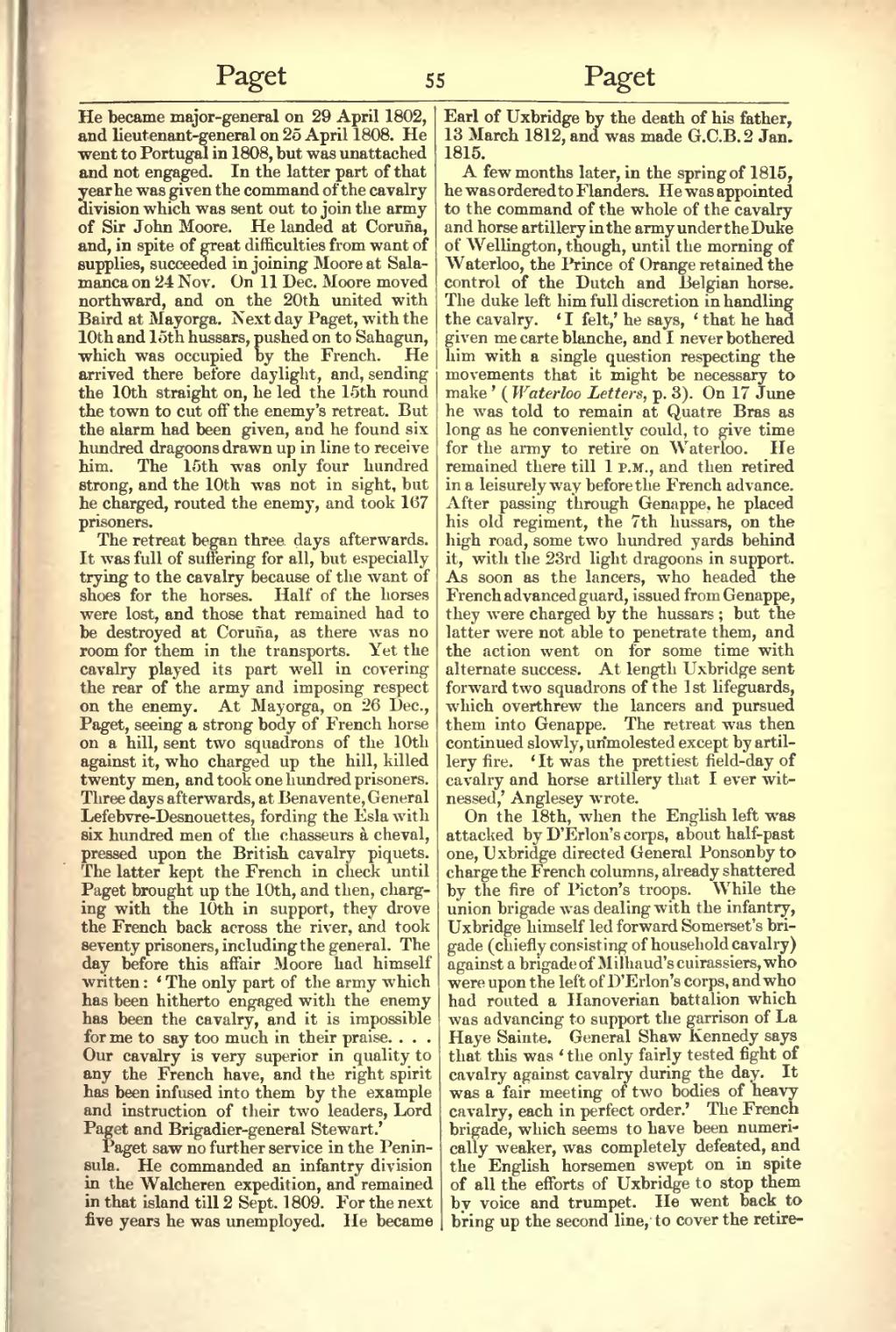He became major-general on 29 April 1802, and lieutenant-general on 25 April 1808. He went to Portugal in 1808, but was unattached and not engaged. In the latter part of that year he was given the command of the cavalry division which was sent out to join the army of Sir John Moore. He landed at Coruña, and, in spite of great difficulties from want of supplies, succeeded in joining Moore at Salamanca on 24 Nov. On 11 Dec. Moore moved northward, and on the 20th united with Baird at Mayorga. Next day Paget, with the 10th and 15th hussars, pushed on to Sahagun, which was occupied by the French. He arrived there before daylight, and, sending the 10th straight on, he led the 15th round the town to cut off the enemy's retreat. But the alarm had been given, and he found six hundred dragoons drawn up in line to receive him. The 15th was only four hundred strong, and the 10th was not in sight, but he charged, routed the enemy, and took 167 prisoners.
The retreat began three days afterwards. It was full of suffering for all, but especially trying to the cavalry because of the want of shoes for the horses. Half of the horses were lost, and those that remained had to be destroyed at Coruña, as there was no room for them in the transports. Yet the cavalry played its part well in covering the rear of the army and imposing respect on the enemy. At Mayorga, on 26 Dec., Paget, seeing a strong body of French horse on a hill, sent two squadrons of the 10th against it, who charged up the hill, killed twenty men, and took one hundred prisoners. Three days afterwards, at Benavente, General Lefebvre-Desnouettes, fording the Esla with six hundred men of the chasseurs à cheval, pressed upon the British cavalry piquets. The latter kept the French in check until Paget brought up the 10th, and then, charging with the 10th in support, they drove the French back across the river, and took seventy prisoners, including the general. The day before this affair Moore had himself written: ‘The only part of the army which has been hitherto engaged with the enemy has been the cavalry, and it is impossible for me to say too much in their praise. … Our cavalry is very superior in quality to any the French have, and the right spirit has been infused into them by the example and instruction of their two leaders, Lord Paget and Brigadier-general Stewart.’
Paget saw no further service in the Peninsula. He commanded an infantry division in the Walcheren expedition, and remained in that island till 2 Sept. 1809. For the next five years he was unemployed. He became Earl of Uxbridge by the death of his father, 13 March 1812, and was made G.C.B. 2 Jan. 1815.
A few months later, in the spring of 1815, he was ordered to Flanders. He was appointed to the command of the whole of the cavalry and horse artillery in the army under the Duke of Wellington, though, until the morning of Waterloo, the Prince of Orange retained the control of the Dutch and Belgian horse. The duke left him full discretion in handling the cavalry. ‘I felt,’ he says, ‘that he had given me carte blanche, and I never bothered him with a single question respecting the movements that it might be necessary to make’ (Waterloo Letters, p. 3). On 17 June he was told to remain at Quatre Bras as long as he conveniently could, to give time for the army to retire on Waterloo. He remained there till 1 P.M., and then retired in a leisurely way before the French advance. After passing through Genappe, he placed his old regiment, the 7th hussars, on the high road, some two hundred yards behind it, with the 23rd light dragoons in support. As soon as the lancers, who headed the French advanced guard, issued from Genappe, they were charged by the hussars; but the latter were not able to penetrate them, and the action went on for some time with alternate success. At length Uxbridge sent forward two squadrons of the 1st lifeguards, which overthrew the lancers and pursued them into Genappe. The retreat was then continued slowly, unmolested except by artillery fire. ‘It was the prettiest field-day of cavalry and horse artillery that I ever witnessed,’ Anglesey wrote.
On the 18th, when the English left was attacked by D'Erlon's corps, about half-past one, Uxbridge directed General Ponsonby to charge the French columns, already shattered by the fire of Picton's troops. While the union brigade was dealing with the infantry, Uxbridge himself led forward Somerset's brigade (chiefly consisting of household cavalry) against a brigade of Milhaud's cuirassiers, who were upon the left of D'Erlon's corps, and who had routed a Hanoverian battalion which was advancing to support the garrison of La Haye Sainte. General Shaw Kennedy says that this was ‘the only fairly tested fight of cavalry against cavalry during the day. It was a fair meeting of two bodies of heavy cavalry, each in perfect order.’ The French brigade, which seems to have been numerically weaker, was completely defeated, and the English horsemen swept on in spite of all the efforts of Uxbridge to stop them by voice and trumpet. He went back to bring up the second line, to cover the retire-
